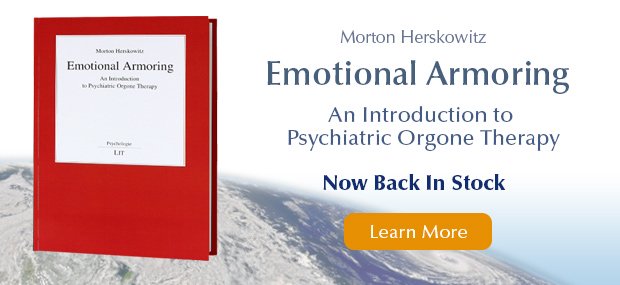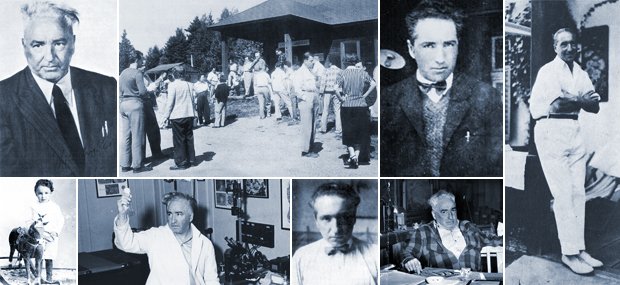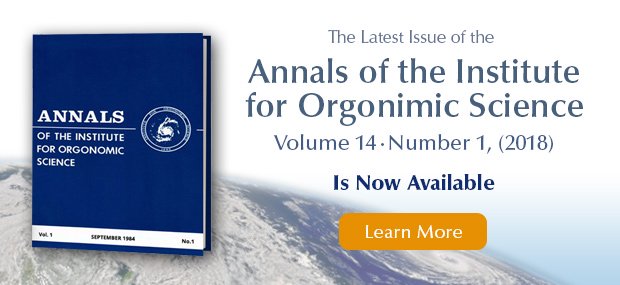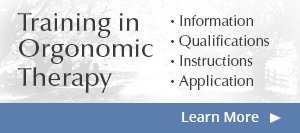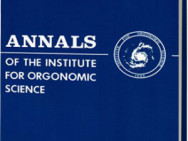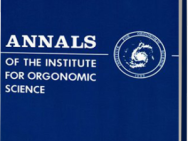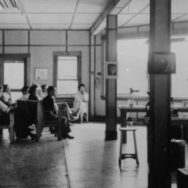Two more issues (Volumes 5 & 6) of the Annals of the Institute for Orgonomic Science are now available for free download online.
These issues contain valuable scientific articles and clinical reports and symposia that we wish to make accessible to as many people as possible. Many thanks to IOS member Stergios Tsiormpatzis for scanning the high-quality pdfs. (Please note – a bound hardcopy of Vol. 5 can still be ordered for your personal library as long as it remains in print, however Vol. 6 is now out of print and only available from us as a pdf).
ANNALS OF THE INSTITUTE FOR ORGONOMIC SCIENCE, Vol. 5 (1988)
“Reich’s Bioelectric Experiments: A Review with Recent Data”
by B. Braid & R.A. Dew
The authors review Reich’s bioelectrical studies of sexuality and anxiety in detail, and present new data concerning dermal electrical potentials in non-erogenous and erogenous zones, and the effects on them of tickling and stroking, pressure, respiration, pain and fright, and sexual excitation. They also report a new finding – a deflection obtained in the palm of the hand upon inspiration and sighing, which they interpret as an expression of organismic pulsation with respiration.
“Human Armoring: An Introduction to Psychiatric Orgone Therapy, Chapter 5:
The Physical Dissolution of Armoring” by M. Herskowitz
This selection contains the fifth chapter of Dr. Herskowitz’s book Emotional Armoring: An Introduction to Psychiatric Orgone Therapy, which was later published in both English and German by LIT Verlag. Dr. Herskowitz’s book can be ordered from the Institute: https://www.orgonomicscience.org/emotional-armoring/
“The Management of a Case of Substitute Contact” by M. Ganz
The author describes the 170 session treatment of a 48 year old man who was first described by the author in “first Do No Harm,” Annals of the Institute for Orgonomic Science, 1: 37-41, 1984 as having been improperly treated by a Reichian therapist who encouraged his forced physical expressions in therapy which served as a defense against feeling genuine emotions. This pattern of substitute contact was evident in his work and love life as well. The author describes in detail his therapeutic approach, and the factors he considered crucial to the patient’s improved functioning.
“A Case of Longstanding Borderline to Mild Hypertension” by A. Nelson
In this case study, the author describes the responses to treatment of a 5’ 10” tall 40-year-old man weighing 176 lbs. who presented with blood pressure of 150/90 mmHg and a history of hypertension since age 25. Remarkably, his prominent chest armor, and much of his ocular armor gave way early in therapy. After his fourth session his internist reported that his blood pressure had declined to 130/75 mmHg and it remained at that level for the next 18 months. Concurrently, during the first 3 to 4 months of therapy, the patient spontaneously and without effort lost 25 lbs. of weight.
“Considerations in the Treatment of Ocular Armoring” D. Schwendeman
Wilhelm Reich developed his technique of character analysis over 50 years ago. Since then, Reich and his followers have discovered the importance of the eyes in emotional life and learned a great deal about armor of the ocular segment. Simultaneously, traditional psychiatry has learned much about pre-oedipal psychopathology. These parallel developments suggest the necessity of a modification of Reich’s technique in the initial phases of therapy with patients who have serious ocular blocks. A change in the orgonomist’s observing position, empathic contact, gratification of the patient’s primary needs, and a temporary de-emphasis of the negative transference are discussed. Finally, some potential problems associated with this therapeutic approach are considered.
“Clinical Symposia: Somatic Biopathies”
The Clinical Symposia contain edited material from the training seminars of the Institute and are intended to provide the readership with information regarding the theory and practice of orgone therapy. In this installment, nine orgone therapists discuss somatic biopathies, including cancer, hypertension, ulcerative colitis and asthma.
“Notes From Afield”
Notes from Afield is intended as a forum for the presentations—in brief synoptic form—of findings from other sciences that bear more or less directly on any aspect of orgonomy. Included in this installment are discussions of “Bechamp: A Discoverer of the Bion Vesicle,” “Pleomorphism,” “Growing Interest in Circumcision and its Effects,” and “Appreciating Reich as an Artist.”
“The Amateur Scientist in Orgonomy: To-T” by C.F. Baker and P.S. Burlingame
This column is intended to encourage “ hands-on” experience with various aspects of Reich’s biological and physical laboratory findings, particularly for interested readers with limited means or access to sophisticated equipment. Each issue will feature an experimental research project that illustrates basic orgonomic findings using only modest equipment and expertise.
This installment presents a protocol for demonstrating and studying the orgone accumulator temperature difference, To-T. Detailed instructions are included describing the construction of an orgone accumulator and control that is thermodynamically balanced to respond to changes in ambient temperature at the same rate as the accumulator. The authors also suggest experiments
to be done with the completed apparatus: study of the diurnal variation in To-T, responses to changes in the weather, the relationship between To-T and the electroscope discharge rate, and the effects of different locations on To-T.
ANNALS OF THE INSTITUTE FOR ORGONOMIC SCIENCE, Vol. 6 (1989)
“Reich’s Experiment XX” by R. A. Dew
Portions of Reich’s Experiment XX have been repeated. The author notes that his findings differ in a number of respects from Reich’s. The most important of these concern the failure to demonstrate convincingly the biological nature and potential of the flakes from the earth bion water as found by Reich. The author also describes the “golden particles” first found by Bernard Grad is his replication of Experiment XX in 1952. The author also presents evidence from distillates of water and earth bion water that may support Reich’s hypothesis that vesicular matter can organize from orgone energy bound to water.
“Reports on Treatments with Orgone Energy” by D. Opfermann-Fuckert
Ten experimental treatments with the orgone accumulator (ORAC) are described. The cases were chosen at random to show an approximate spectrum of possibilities where the ORAC mav be used. The maladies ranged from simple trauma (burns) to serious biopathies (carcinoma). Observation times varied with the type of malady treated. The Reich blood test was applied in six of the cases over the course of observation. The treatment results in all ten cases confirmed the effectiveness of the physical orgone treatment according to the criteria Reich summarized under the “B-reaction.” The present article also deals with certain general problems of orgone treatment, such as a possible oranur reaction in the hospital, the therapeutic limitations in treating cancer, and the necessity of statistically evaluable investigations.
“Human Armoring: An Introduction to Psychiatric Orgone Therapy, Chapter 6:
Theory – Orgone Energy” by M. Herskowitz
This selection contains the sixth chapter of Dr. Herskowitz’s book Emotional Armoring: An Introduction to Psychiatric Orgone Therapy, which was later published in both English and German by LIT Verlag. Dr. Herskowitz’s book can be ordered from the Institute: https://www.orgonomicscience.org/emotional-armoring/
“Clinical Symposia”
The Clinical Symposia contain edited material from the training seminars of the Institute and are intended to provide the readership with information regarding the theory and practice of orgone therapy. In this installment, six orgone therapists discuss couples counseling and family therapy as they relate to the practice of psychiatric orgone therapy.
“The Amateur Scientist in Orgonomy: The Reich Blood Test” by C. F. Baker
and P. S. Burlingame
This column is intended to encourage “ hands-on” experience with various aspects of Reich’s biological and physical laboratory findings, particularly for interested readers with limited means or access to sophisticated equipment. Each issue will feature an experimental research project that illustrates basic orgonomic findings using only modest equipment and expertise.
This installment presents a protocol for conducting the first of the three Reich blood tests, in which the bionous disintegration of blood is followed in physiological saline solution (the autoclavation test and the blood culture test are not treated here). The authors discuss important macroscopic and microscopic observations to be made during the test. They also describe how to graph % bionous erythrocytes vs. time, and how to calculate the 1% time, the theoretical time at which bionous disintegration began.

